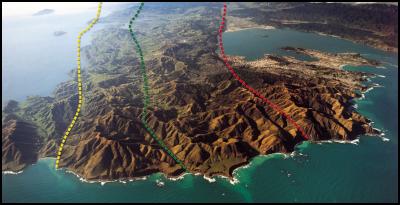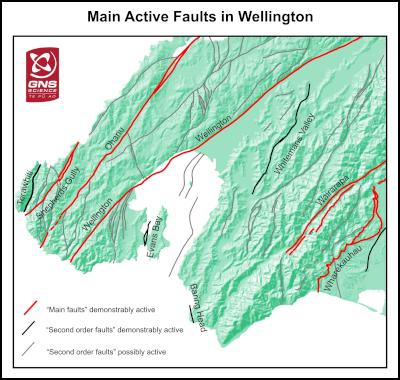New Research Shows Lower Threat From Wgtn Fault
Media Release
18 September 2009
New Research Shows Lower Threat From Wellington Fault

Click for big version
Shepherds Gully Fault (yellow), Ohariu Fault (green), Wellington Fault (red)
The major fault running
through Wellington City is about 50 per cent less likely to
rupture in the next 100 years than previously thought,
according to research carried out under the ‘It’s Our
Fault’ project.
Project Leader Russ Van Dissen, of GNS Science, points out that earthquakes will still occur in the Wellington region and the need to be prepared remains the same.
“There are about 50 active faults in the Wellington region and many of them are capable of producing a damaging earthquake,” Mr Van Dissen said.
Scientists have found that the Wellington Fault, regarded until recently as primed and capable of producing a big earthquake fairly soon, has longer quiet spells between big ruptures than was generally accepted.
‘It’s Our Fault’ is a seven-year, multi-agency project to improve the knowledge of the frequency, size and impacts of earthquakes in the Wellington region.
The $3.5 million project started in 2006 and is the most comprehensive study of earthquake risk in Wellington to date.
“For some years we have suspected that Wellington’s reputation for being ‘overdue for the big one’ was an exaggeration,” Mr Van Dissen said.
“Now that we have a more accurate picture of the hazard posed by the Wellington Fault, we expect this will assist civil defence planning and reduce uncertainty for those making business investment decisions.”
The Wellington Fault extends between Wellington and the Bay of Plenty. However, the study focused on the 80km-long segment closest to the Capital. It starts in Cook Strait and extends through Karori and Wellington City and along the Hutt Valley into the Tararua Mountain Range.
Until recently, available evidence suggested that this southern segment ruptured at intervals of about 600 years and last ruptured about 450 years ago, producing an earthquake of at least magnitude 7.
The new findings show it ruptures about every 900 years and last ruptured about 300 years ago.
“We are delighted to have made solid progress in understanding the Wellington Fault and its threat to the Wellington region,” Mr Van Dissen said.
The findings come from detailed geological investigations to better characterise the earthquake activity of the faults in the Wellington region. The project also incorporated the accurate mapping of Cook Strait faults by the National Institute of Water and Atmospheric Research (NIWA).
Scientists have also used Global Positioning System (GPS) studies to better understand the movement of the tectonic plates under Wellington, as well as computer modelling of the complex relationships among the many faults in the lower North Island.
The work has been a collaborative effort involving GNS Science, NIWA, Victoria University of Wellington, and the University of Canterbury.
Mr Van Dissen said a reduced likelihood of the Wellington Fault rupturing in the near future did not mean that damaging earthquakes were no longer a threat to Wellington.
Moderate-sized local earthquakes – magnitude 6.0 to 6.9 – or larger distant earthquakes, now have more relevance in terms of planning and preparedness in Wellington.
“Strong ground-shaking from these categories of earthquakes could be expected to occur several times in an average person’s lifetime.”
Earthquakes of moderate magnitude generally cause damage over a smaller area. The resultant impact on communities and infrastructure would be less than a rupture of the Wellington Fault, which is expected to produce an earthquake of about magnitude 7.5.
“However, smaller magnitude earthquakes are more frequent than large ones,” Mr Van Dissen said.
The new knowledge and understanding being built through this project will enable more accurate hazard and risk estimates for the Wellington region. This will benefit a wide range of industries and agencies, help boost community resilience, and facilitate quick recovery from a damaging earthquake if proper preparation is in place.
To date the ‘It’s Our Fault’ project is supported by the Earthquake Commission, Wellington City Council, the Accident Compensation Corporation, and the Foundation for Research Science and Technology. Greater Wellington Regional Council has recently committed to support the project.
Note: The Richter or Local magnitude scale for earthquakes assigns a number to quantify the amount of energy released by an earthquake. It is a logarithmic scale meaning an increase of a whole unit – magnitude 6.0 to magnitude 7.0 – represents 30 times more energy produced. An increase of two units – magnitude 5.0 to magnitude 7.0 – represents 900 times more energy. The energy released by an earthquake closely relates to its destructive power.
ENDS



 Gordon Campbell: On The Public Sector Carnage, And Misogyny As Terrorism
Gordon Campbell: On The Public Sector Carnage, And Misogyny As Terrorism National Maori Authority: Maori Authority Warns Government On Fast Track Legislation
National Maori Authority: Maori Authority Warns Government On Fast Track Legislation NZ Government: Comprehensive Partnership The Goal For NZ And The Philippines
NZ Government: Comprehensive Partnership The Goal For NZ And The Philippines DoC: Canterbury Spotted Skink In Serious Trouble
DoC: Canterbury Spotted Skink In Serious Trouble Te Pāti Māori: Oranga Tamariki Cuts Commit Tamariki To State Abuse
Te Pāti Māori: Oranga Tamariki Cuts Commit Tamariki To State Abuse NZCTU: Inflation Data Shows Need For A Plan On Climate And Population
NZCTU: Inflation Data Shows Need For A Plan On Climate And Population Statistics New Zealand: Annual Inflation At 4.0 Percent
Statistics New Zealand: Annual Inflation At 4.0 Percent


